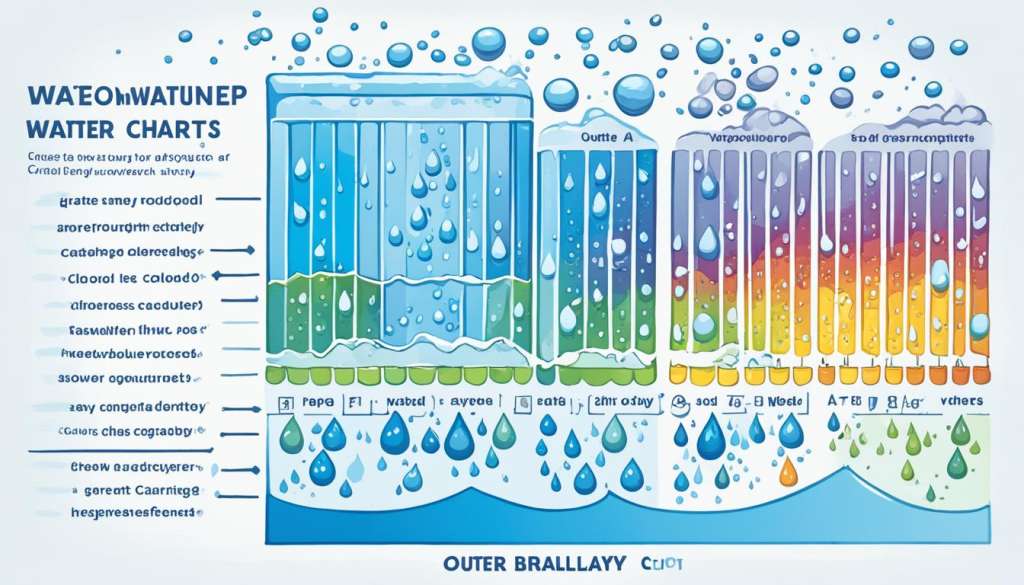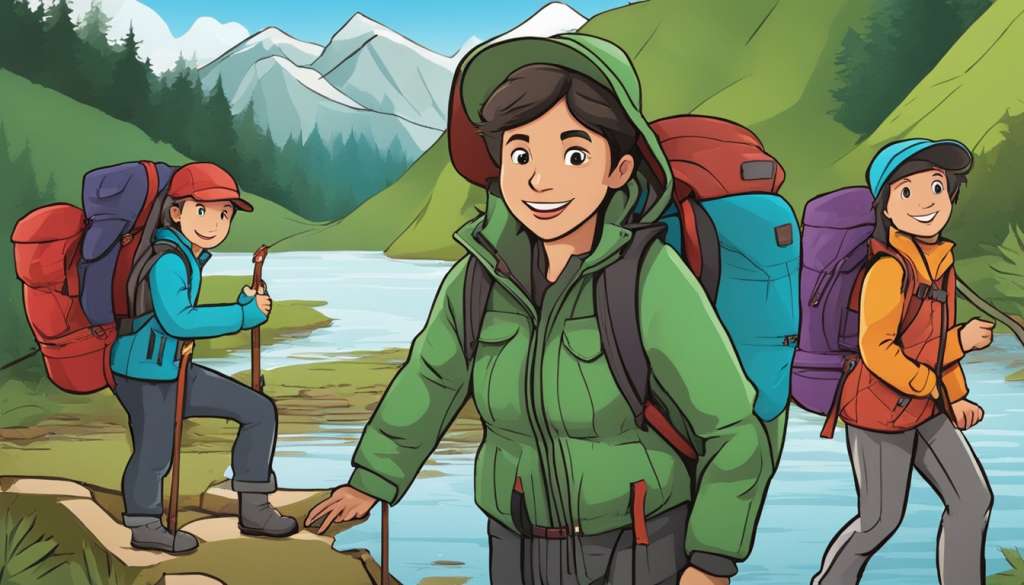Your outdoor adventures need reliable waterproof gear. This guide will show you how to pick the right waterproof outer layers for your activities. Whether you’re hiking in light drizzle or facing heavy rain, having the right gear is key to staying dry and comfy.
Waterproof outer layers are the last line of defense in your layering system. They work with moisture-wicking base layers and insulating mid-layers to keep you dry and warm. The type of waterproof gear you choose depends on your outdoor activities and the weather you’ll encounter.
From jackets to pants, each waterproof piece is vital for your outdoor kit. Knowing how these layers work together will make sure you’re ready for any adventure, rain or shine.
Understanding the Importance of Waterproof Outer Layers
Waterproof jackets are key for those who love the outdoors. They keep you safe from bad weather, making your adventures fun. Let’s see why they’re a must-have for your gear.
Why Waterproof Gear is Essential for Outdoor Activities
When you’re out in nature, staying dry is crucial. Waterproof gear keeps you dry in sudden rains, so you can enjoy your time outside. It lets you focus on what you’re doing, not on getting wet.
The Role of Waterproof Layers in the Layering System
Waterproof layers are important for managing moisture. They’re the outer part of your layers, working with base and mid-layers. Together, they keep your body temperature right and move sweat away, keeping you comfy outside.
Benefits of Investing in Quality Waterproof Outerwear
Buying top-notch waterproof outerwear is a smart choice. These jackets last longer, breathe better, and protect you from the elements. They keep you dry and comfy, letting you fully enjoy your outdoor activities.
| Feature | Benefit |
|---|---|
| Waterproof Membrane | Keeps rain and snow out |
| Breathable Fabric | Allows sweat to escape |
| Taped Seams | Prevents water penetration at stitching points |
| Adjustable Hood | Provides customized head protection |
Types of Waterproof Outer Layers
When you’re out in the wild, the right waterproof gear is key. Let’s look at the different waterproof outer layers you’ll find when you shop next.
Hard shell jackets are top-notch for keeping you dry. They have fully taped seams and weatherproof zippers. So, whether you’re climbing a mountain or facing a storm, you’ll stay dry.
Soft shell jackets are great for staying warm and comfy while being active. They stretch and breathe well, perfect for milder weather. They’re not fully waterproof but keep out light rain and wind, making them versatile for many outdoor activities.
Rain coats are perfect for wet days. They’re light, easy to carry, and keep you dry in sudden showers. Today’s rain coats also look good, showing you can be stylish and dry.
Don’t overlook waterproof pants for your lower half. They’re key for staying dry from head to toe. Whether you’re hiking or skiing, these pants keep you comfy and dry, letting you enjoy your outing without worrying about wet clothes.
| Outer Layer Type | Best For | Water Resistance | Breathability |
|---|---|---|---|
| Hard Shell Jackets | Extreme conditions | Excellent | Good |
| Soft Shell Jackets | Active pursuits | Moderate | Excellent |
| Rain Coats | Urban use | Good | Fair |
| Waterproof Pants | All-day protection | Excellent | Varies |
Picking the right waterproof layer depends on what you’re doing and the weather. Think about how breathable, durable, and easy to carry it is. With the right gear, you’ll be ready for whatever the weather brings.
Waterproof Jacket Technologies: Gore-Tex, eVent, and DryVent
Waterproof jacket technologies have changed outdoor gear. They mix waterproof membranes with breathable fabrics to keep you dry and comfy. Let’s look at three top technologies that have made a big impact on outdoor lovers.
How Gore-Tex Works
Gore-Tex leads in making waterproof fabrics that breathe. Its membrane has over 9 billion tiny pores per square inch. These pores are tiny, but they let sweat out while keeping rain out. This keeps you dry from the outside and inside.
eVent: A Breathable Alternative
eVent takes a new path in waterproofing. It doesn’t need a polyurethane layer like Gore-Tex. Its direct venting lets sweat vapor go through fast. This means you stay dry during intense activities, making eVent popular with athletes and serious adventurers.
The North Face’s DryVent Technology
DryVent is a waterproof tech by The North Face. It has a multi-layer design to keep moisture out and let air in. DryVent fabric is tested hard to meet top standards for waterproofing, breathability, and lasting power.
| Technology | Waterproof Rating | Breathability Rating | Best For |
|---|---|---|---|
| Gore-Tex | 28,000mm | 17,000g/m²/24hrs | All-around use |
| eVent | 30,000mm | 22,000g/m²/24hrs | High-intensity activities |
| DryVent | 25,000mm | 15,000g/m²/24hrs | Everyday outdoor use |
Each technology has its own perks. Your pick depends on what you need and what you do outside. The best waterproof jacket is the one that keeps you dry and comfy in your adventures.
Understanding Waterproof Ratings and Breathability
Choosing the right outdoor gear means looking at waterproof ratings and breathability. These features help keep you safe from the elements and keep you comfy. They’re key to your gear’s performance.
Waterproof standards use water column ratings. This shows how much water pressure a fabric can take before it leaks. The higher the rating, the better it keeps water out.

Breathability is also vital. It measures how much moisture the fabric lets through in a day. This is shown in grams per square meter per day (g/m²/24hrs).
| Water Column Rating (mm) | Waterproof Level | Suitable For |
|---|---|---|
| 0-5,000 | Water-resistant | Light rain, dry snow |
| 5,000-10,000 | Waterproof | Moderate rain, average snow |
| 10,000-20,000 | Very waterproof | Heavy rain, wet snow |
| 20,000+ | Extremely waterproof | Torrential rain, extreme conditions |
When picking gear, think about both waterproof ratings and how breathable it is. Finding a good balance means you stay dry from outside and inside moisture. Remember, higher ratings usually mean better protection, but your needs can change with your activities and the weather.
The Science Behind DWR Coatings
Durable Water Repellent (DWR) coatings are key to making waterproof gear work better. They keep you dry and comfy during outdoor fun.
What is DWR?
DWR is a special treatment put on waterproof clothes. It makes a water-resistant layer that lets water bead up and roll away. This boosts the waterproofing of your outdoor stuff.
How DWR Enhances Waterproofing
The hydrophobic treatment makes fabric surfaces more resistant to water. Water forms beads and doesn’t soak into the material. DWR coatings work with other waterproofing tech to keep your gear dry in all kinds of weather.
Maintaining and Reapplying DWR Coatings
Over time, DWR coatings can fade from use and washing. To keep your waterproof gear working well:
- Clean your clothes as the maker says
- Use DWR products to reapply the coating when it’s needed
- Apply heat (like low tumble drying) to reactivate the DWR
Looking after your DWR-treated gear right can make it last longer and stay water-repellent for more adventures.
Choosing the Right Waterproof Pants
When you go outside, the right rain pants can make your adventure better or worse. Waterproof trousers are key for staying dry and comfy in the wet. Let’s look at how to pick the best pair for you.
First, think about what you’ll be doing outside. Hiking needs different things than biking or skiing. For hiking, pants with articulated knees help you move better. If you’re biking, look for pants with reflective parts to be seen.
The weather also affects your choice. In mild weather, light rain pants might be enough. But for tough weather, go for thicker, stronger waterproof pants. Remember, pants that breathe well are important for staying comfy when you’re active.
Here are some key features to consider:
- Side zips for easy on/off over boots
- Adjustable waistbands for a custom fit
- Reinforced seat and knees for durability
- Sealed seams to prevent water seepage
Your personal likes also play a part. Some hikers like pants that turn into shorts. Others want pants that pack easily for backpacking.
| Feature | Importance | Best For |
|---|---|---|
| Articulated knees | High | Hiking, Climbing |
| Side zips | Medium | All activities |
| Reinforced seat | High | Skiing, Snowboarding |
| Convertible design | Low | Multi-day hikes |
The best waterproof pants offer protection, breathability, and comfort. Think about what you need, and you’ll find the perfect pair for your outdoor adventures.
Waterproof Outer Layers Guide: From Jackets to Accessories
A waterproof system is more than just jackets and pants. You need various accessories to stay dry on outdoor adventures. Let’s look at key waterproof gear to keep you dry and comfy.
Waterproof gloves are key for dry and warm hands. They should have sealed seams and breathable membranes. These features let moisture out while keeping water out.
Gaiters keep your feet and lower legs dry by fitting over your boots and pants. They act as a barrier against rain and mud. Pick gaiters made from strong, water-resistant materials for the best shield.
Waterproof hats protect your head from rain and sun. Some hats even have built-in neck covers for more protection. If you like your regular hat, get a waterproof cover for it.
Backpack covers are vital for keeping your gear dry. They go over your pack to shield it from rain and splashes. Many are light and fold up small when not needed.
| Accessory | Key Features | Benefits |
|---|---|---|
| Waterproof Gloves | Sealed seams, breathable membrane | Dry hands, improved dexterity |
| Gaiters | Durable material, adjustable fit | Dry feet and legs, mud protection |
| Waterproof Hats | Wide brim, neck cover | Face and neck protection |
| Backpack Covers | Lightweight, packable | Dry gear, easy storage |
With these accessories and your waterproof jacket and pants, you have a full system for wet weather. The right gear makes a big difference in your outdoor adventures.
Layering Techniques for Maximum Weather Protection
Learning how to layer is key to staying comfy and safe outside. The right mix of moisture-wicking base layers, insulating mid-layers, and waterproof shells is crucial. This combo greatly improves your outdoor experience.

Base Layer Considerations
Your base layer is the base of your outdoor clothes. Choose moisture-wicking materials like Merino wool or synthetic fabrics. These materials take sweat away from your skin, keeping you dry and comfy during active times.
Mid-Layer Options for Insulation
Mid-layers keep heat close to your body. Fleece, down, and synthetic insulated jackets are top picks. The best choice depends on how active you are and the weather you’ll face.
Outer Layer Selection Based on Activity and Climate
Your outer layer, or shell, shields you from wind and rain. Pick waterproof shells for wet weather or windproof jackets for dry, windy places. Think about how hard you’ll be moving and the climate when choosing your outer layer.
| Layer | Function | Material Options |
|---|---|---|
| Base Layer | Moisture management | Merino wool, synthetic fabrics |
| Mid-Layer | Insulation | Fleece, down, synthetic fill |
| Outer Layer | Weather protection | Waterproof/breathable fabrics, windproof materials |
Understanding these layering tips lets you build a flexible outdoor outfit. It adjusts to weather and activity levels. Always adjust your layers as you go to keep comfy and safe.
Caring for Your Waterproof Gear
Looking after your waterproof gear is key to keeping it in top shape. It helps your outdoor adventures stay dry and comfy. Here are some important tips for cleaning waterproof jackets and reproofing your gear.
First, check the care label for the manufacturer’s instructions. Different materials need different cleaning methods. You should wash your waterproof gear in cool water with a cleaner made for technical fabrics. Don’t use regular detergents or fabric softeners, as they can harm the waterproof coating.
After washing, make sure to rinse your gear well to get rid of all soap. Let it air dry, keeping it away from direct heat like radiators or tumble dryers. Once it’s dry, you might need to add a durable water repellent (DWR) treatment to keep it water-repellent.
- Use a gear-specific cleaner
- Wash in cool water
- Rinse thoroughly
- Air dry away from heat
- Reapply DWR as needed
It’s important to reproof your gear regularly to keep it waterproof. To check if you need to reproof, sprinkle water on the surface. If the water beads up and rolls off, your DWR is working well. But if the water soaks in, it’s time to reproof.
Remember, taking good care of your gear not only makes it last longer. It also keeps you safe and dry during your outdoor adventures.
Waterproof vs. Water-Resistant: Understanding the Difference
When picking outdoor gear, you’ll often see “waterproof” and “water-resistant.” These terms are not just marketing tricks. They show big differences in how well they protect you from moisture. Waterproof materials keep you dry in heavy rain or snow by using special fabric technologies.
Water-resistant items, however, don’t keep you dry in wet conditions. They’re good for light rain or a quick splash. The protection level depends on the fabric and treatments used. If you’re doing activities with little water contact, water-resistant gear might be enough.
Your choice between waterproof and water-resistant gear depends on your activities and the weather. For mountain hiking or long rainy days, go for waterproof items. For casual walks or light drizzles, water-resistant gear could work. Remember, taking good care of your gear keeps it effective over time.

